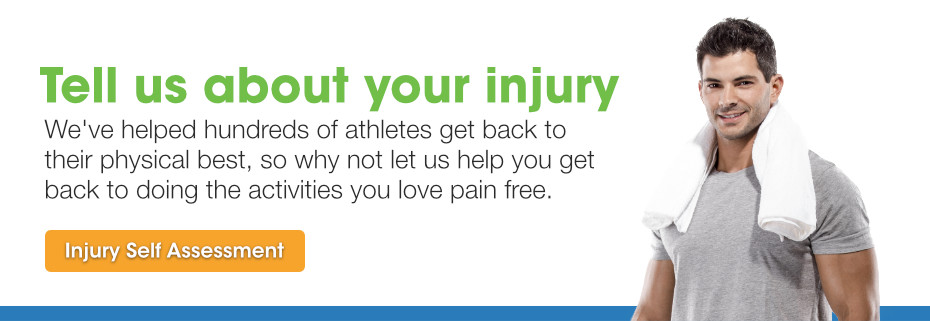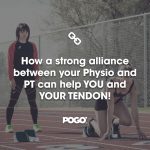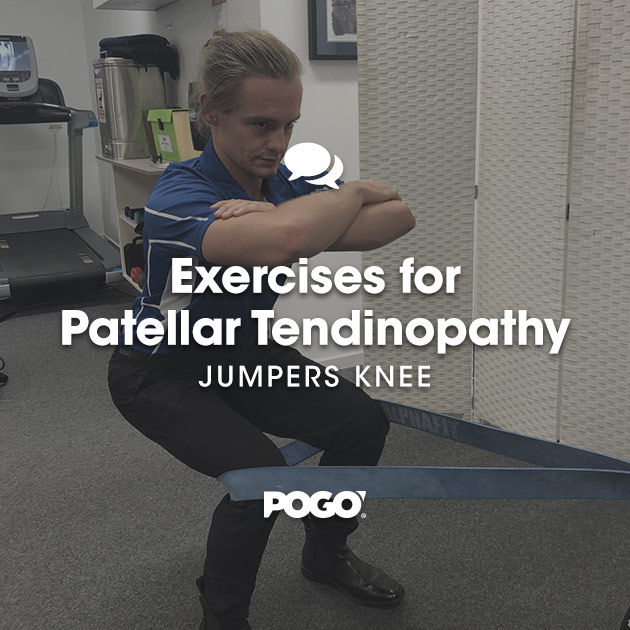How to Rehabilitate a Tendinopathy: Phase 1 (Reducing symptoms & pain)
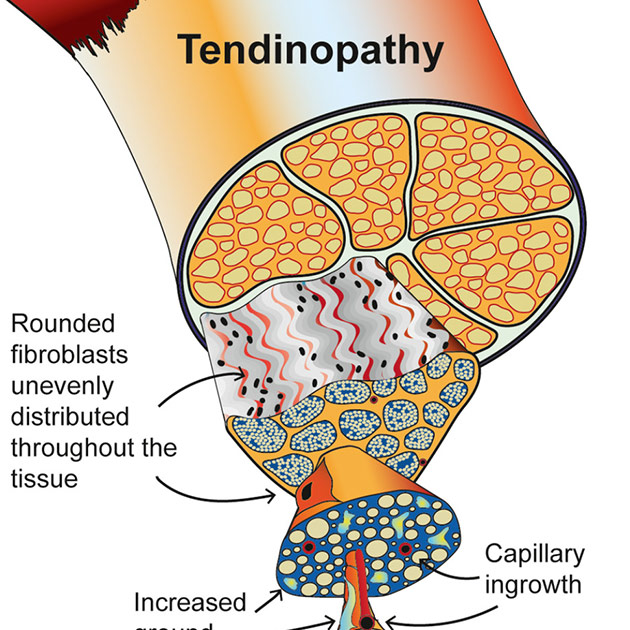
Rehabilitation of lower limb tendinopathies is something that constitutes a large portion of my clinical practice.
Tendinopathies can be difficult to treat. Successful rehabilitation typically takes time. It is not uncommon for some lower limb running tendinopathy rehabilitation timelines to require many months, in some persistent cases even years.
As a result successful rehabilitation requires perseverance and patience from both the injured runner and also the treating practitioner.
What causes tendinopathy?
The exact aetiology of tendinopathy remains largely unknown.
Classical symptoms and signs of lower limb tendinopathy include: pain that is typically localised to a specific area of tendon, reduced strength and performance from the tendon, and occasionally swelling and/or thickening of the affected tendon.
Tendinopathy is not limited to a certain age group or demographic. Symptomatic tendinopathy can be experienced by runners of all ages, abilities, and running backgrounds.
In this two part blog series we will explore the two phases required to rehabilitate a tendon: Phase 1 symptom reduction, and Phase 2 the restoration of the energy storage capacity of the lower limb tendon.
Normal structure and function a tendon
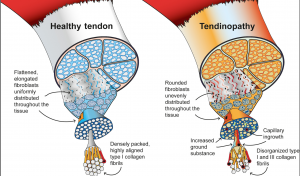
Figure source: Pathogenesis and management if tendinopathies in sports medicine (Transl Sports Med)
How to treat a tendinopathy
There are many treatment modalities that exist for treating tendinopathies. The aim of this post is to explore the pathway that typifies most lower limb tendinopathy rehabilitations, and to also explore the merit of a few commonly used treatment options.
Tendinopathy rehabilitation roadmap
Given that tendon rehabilitation takes time I like to use the below diagram to outline the expected tendon rehabilitation journey.
The diagram is modified from Dr Peter Malliaras’ Mastering Lower Limb Tendinopathy course).
When the expectations and typical journey of tendon rehabilitation are made known at the beginning of the rehabilitation process, there tends to be less anxiety, and more acceptance that the rehabilitation will take time and require active participation.
This roadmap for tendon rehabilitation is useful for us to consider in understanding the general rehabilitation journey required to resolve lower limb tendinopathies of the: proximal hamstring tendon, achilles tendon, and patellar tendon.
While there is a natural proclivity and desire by any tendon pain sufferer to have their tendon pain rehabilitated as quickly as possible and with as little effort as possible, successful tendon rehabilitation always requires active participation and patience.
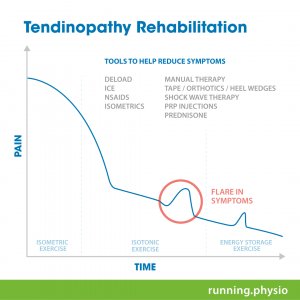
The two general phases of tendinopathy rehabilitation
Phase 1: Reducing Pain/Symptoms
It should be noted that phase 1 and phase 2 are not mutually exclusive. The phases will overlap with no definitive end and start of the next phase.
The first phase of rehabilitation is to attempt to reduce pain and symptoms as quickly as possible.
This desired rapid reduction in symptoms is depicted in the diagram by the ‘steep drop off’ of pain shown on the left side of the diagram. I refer to this desired rapid reduction in pain and symptoms with patients as trying to throw the pain off a cliff.
Clients receiving treatment for their tendinopathy appreciate this notion and on citing the graph can conceptualise what their rehabilitation is initially targeted toward and trying to achieve: that is symptom modification and pain reduction.
There exists a variety of tools that exist to assist with this throwing the pain off a cliff (as outlined in the diagram). These tools are as follows:
A. Deloading of the affected tendon/body region
Deloading of the affected tendon means reducing the impact loading. There are no set ‘rules’ or scientifically established best protocols for how exactly by which to deload by. Deloading of the affected structure/body region/tendon is best done on ‘feel’ and symptom response as directed by the treating practitioner.
One approach is to reduce the loading the tendon is subject to by half. For example take a runner suffering from persistent achilles tendinopathy who has been running 50kms per week. One approach to reducing the loads on the symptomatic tendon could be to reduce the runner’s running volume immediately by 50%, to running 25kms per week. If symptoms remain unchanged than a further reduction of 50% in running volume may be required. If symptoms remain with these two 50% reductions in then complete rest may be required. The same deloading principles can apply to non runners suffering from lower limb tendinopathies. For example a worker who stands on their feet all day may find it helpful to reduce their standing time at work, to potentiate a reduction in symptoms of say achilles tendinopathy.
B. Ice.
The use of ice can be helpful for reducing the pain of reactive and degenerative tendinopathies following aggravating activities such as running. Ice can be applied with traditional ice packs or more advanced technologies such as the Aircast Cryocuff could also be potentially very useful for icing/cooling/compression of achilles tendon injuries (See the Cryocuff below). Cryocuff units can be purchased outright or hired for minimal fees through health centres (including POGO Physio).
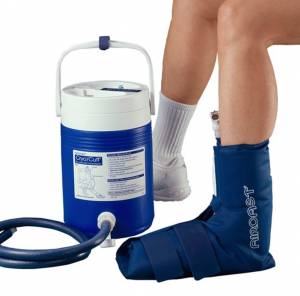
C. Non-steroidal anti-inflammatory medications (NSAIDS) use.
NSAIDS function to block the production of prostaglandins. Prostaglandins are molecules which play a role in the development of acute inflammation. NSAIDs seem to have use in the utility of alleviating acute pain associated with tendinopathies. They are a popular choice by practitioners and non practitioners alike in the initial management of symptoms. NSAIDs are generally effective as short term analgesics for tendon conditions by reducing pain and inflammation.
These anti -inflammatories can be prescribed over the counter (OTC) or, alternately issued by prescription by a general practitioner (GP), sports doctor, or specialist. The use of anti-inflammatories is routine practice. The use of anti-inflammatory medication can be thought by some patients to ‘mask their pain’ but rather it helps to reduce initial symptom irritability and allow for more rapid commencement of exercise rehabilitation.Generally prescription anti-inflammatories will tend to be more effective than over the counter dosages.
There is some evidence to suggest that use of NSAIDs may negatively impact tendon healing by impairing the proliferation of tenocytes (tendon cells), so some degree of caution should be taken with their use.
I am often heard telling patients that while initial pain relief through medication use is in many instances both helpful and important ‘there is no pill but there is a process’. This helps the recovering runner understand that an active approach to rehabilitation (involving loading exercises) is required.
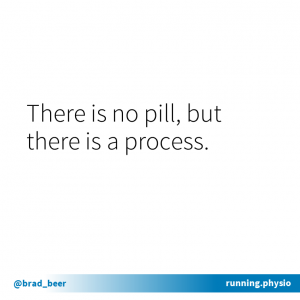
D. Extracorpeal shockwave (ESWT) therapy
Shockwave therapy may be a useful adjunct to assisting with pain or symptom reduction for lower limb tendinopathies. The evidence base is varied however shockwave therapy has been shown:
- to be beneficial for achilles tendinopathy (insertional and midportion) at 3 months (2)
- a safe and promising treatment for patellar tendinopathy with a positive effect on pain and function (3)
- to be a safe and effective treatment for patients with chronic proximal hamstring tendinopathy (4).
My approach to the use of ESWT in the treatment of lower limb tendinopathies is to trial the use and monitor the 24hr response to administration. If the patient reports feeling less stiff or sore following ESWT than I may decide to continue to use ESWT while the pain in the tendon remains.
It must be noted that using EWST is itself not the ‘solution for lower limb tendinopathies. Rather it is a useful adjunct to hopefully assist with pain and symptom reduction in the initial phase of rehabilitation. It needs to be understood that only exercise and a progressive loading program to restore the affected tendon’s capacity to loads will rehabilitate the tendon.
If pain /symptom reduction can be enhanced through ESWT and allow for earlier loading of the tenon through exercise rehabilitation than it can be a very useful tool.
E. Manual therapy
Manual therapy (hands on treatment: massage therapy, mobilisation techniques etc) really does not have a huge role to play in the treatment of lower limb tendinopathies. In the initial phase of rehabilitation I may use soft tissue techniques such as remedial massage therapy or myofascial release techniques on the surrounding musculature of an irritated tendon. For example if I am treating an achilles tendinopathy in the initial phases of treatment (ie first few sessions) I may perform 2-5mins of soft tissue massage on the gastrocnemius, soleus, and tibialis anterior.
It should be noted that pushing and ‘poking’ sore tendons is NOT advisable. Poking, squeezing, and prodding of irritated tendon tissue will tend to sensitise the affected tendon and increase soreness and symptoms.
Think of your sore tendon like a bruise -don’t poke it-leave it alone!
F. Tape/orthotics/heel wedges
The use of tape, orthotics, and heel wedges can assist with the initial reduction in pain and symptoms from lower limb tendinopathies such as achilles tendinopathy.
I will often apply tape to the foot of an achilles tendon sufferer who is experiencing marked pain from an irritable tendon. The aim of the tape being to deload the affected tissue. The taping technique I will use is shown in the video below:
Tape can also be applied for glute medius tendinopathy as shown below. I tend to use the below tape technique sparingly but it can be useful for patients with very reactive tendinopathy to avoid the legs crossed position which tends to be provocative.
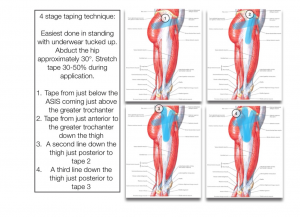
Patellar tendinopathy taping is shown below:
Orthotics use may be helpful for some lower limb tendinopathies such as achilles tendinopathy, but research findings are mixed (1).
Heel wedges can be useful adjuncts to initial treatment in particular for achilles tendinopathy. They have been shown to be helpful by reducing the strain and loading through the achilles tendon by reducing the amount of dorsi-flexion at the ankle joint (5) see below:
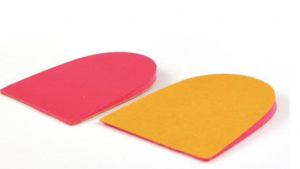
G. Platelet Rich Plasma (PRP) injections
Platelet rich plasma injection therapy grew several years ago in popularity as a purported way to accelerate healing in a number of musculoskeletal conditions such as tendinopathy. It involves the injection of platelet rich plasma into the affected area. I was initially a proponent of sending clients with persistent and slow responding tendinopathies for a series of PRP injections, however in recent years I have not sent clients for this treatment. It tends to be expensive and from my clinical experience not overall that effective. Research results for the use of PRP in treating tendinopathy are mixed.
To read more about PRP therapy refer to the below previously published blogs:
A physio’s guide to PRP therapy and injections HERE>>
PRP so where do we stand now? HERE>>
H. Corticosteroids (including Prednisone)
Corticosteroid injections are unadvisable for tendinopathy treatment. They have been found to increase the potential for iatrogenic tendon rupture and atrophy of the surrounding soft tissues. Despite this increased risk of rupture when tendons are injected with corticosteroid many sufferers will be advised that injections may be useful. Evidence is unsubstantiated with regards to the use of corticosteroids for achilles tendinopathy (6).
For persistent tendon pain the short term use of Prednisone may be helpful for desensitising the tendon and allowing for loading and exercise therapy to commence.
Phase 2: Restoration of the energy storage capacity of the tendon
We will explore the second phase of tendon rehabilitation in the next blog instalment. It’s important to note that reducing symptoms and improving the capacity of the tendon are not mutually exclusive processes or aims of treatment. They will co-exist.
However it is prudent that the symptoms are initially brought under control in the quickest manner possible during Phase 1 of rehabilitation in order for Phase 2 efforts to be maximised.
Related:
Physio With a Finish Line®,
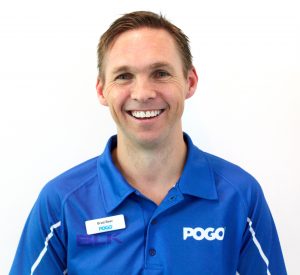
Brad Beer (APAM)
Physiotherapist (APAM)
Author ‘You CAN Run Pain Free!’
Founder POGO Physio
Host The Physical Performance Show
Featured in the Top 50 Physical Therapy Blog
References
(1)Effectiveness of Orthotic Devices in the Treatment of Achilles Tendinopathy: A Systematic Review. Scott, L.A., Munteanu, S.E. & Menz, H.B. Sports Med (2015) 45: 95. https://doi.org/10.1007/s40279-014-0237-z
(2) The Effectiveness of Extracorporeal Shock Wave Therapy on Chronic Achilles Tendinopathy: A Systematic Review, Hani Al-Abbad, PT, BSc, MMSPhty and Joel Varghese Simon, PT, MMSPhty, Foot & Ankle International , Vol 34, Issue 1, pp. 33 – 41.
(3) van Leeuwen MT, Zwerver J, van den Akker-Scheek I, Extracorporeal Shockwave Therapy for Patellar Tendinopathy; a review of the literature. British Journal of Sports Medicine Published Online First: 21 August 2008. doi: 10.1136/bjsm.2008.050740.
(4) Shockwave Therapy for the Treatment of Chronic Proximal Hamstring Tendinopathy in Professional Athletes. Angelo Cacchio, MD, Jan D. Rompe, MD, John P. Furia, MD, Piero Susi, MD, Valter Santilli, MD, and Fosco De Paulis, MD. The American Journal of Sports Medicine, Vol 39, Issue 1, pp. 146 – 153.
(5) The effects of orthotic heel lifts on Achilles tendon force and strain during running.
J Appl Biomech. 2012 Nov;28(5):511-9. Epub 2012 May 8.
Farris DJ1, Buckeridge E, Trewartha G, McGuigan MP.
(6) Kearney RS, Parsons N, Metcalfe D, et al Injection therapies for achilles tendinopathy. Cochrane Databse Syst Rev 2015; (5): CD010960.
